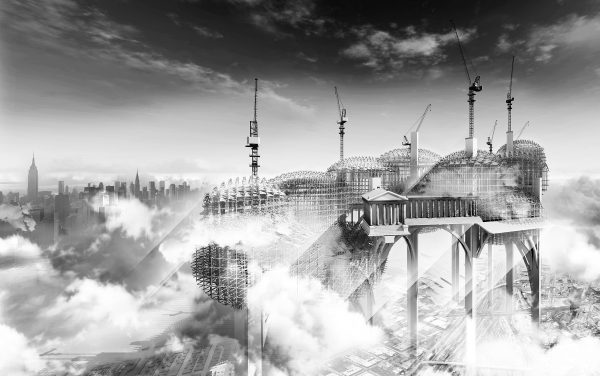Editors’ Choice
2018 Skyscraper Competition
Chi-Jen Wang
United Kingdom
The Reciprocal Utopia City project is a renewable energy city in the sky. It forms a cloud-like structure rising into the sky to 1,100 meters high and parallel to New York City.
The focus of this project is consists of two parts. How architecture can serve as a mechanism to facilitate escapism, in the context of the domination of capitalism, taking it as a strategic site to study. Meanwhile, it explores the new way of imaging renewable energy system by using potential technology.
The Situationist International once described a dream society: New Babylon. The Nomadic city develops the idea of a “traveling metropolis”, a package that infiltrates temporarily into a community. The mobility of architecture. “It is obvious that a person is free to use his time for the whole of his life, free to go where he wants, when he wants, cannot make the greatest use of his freedom in a world ruled by the clock and the imperative of a fixed abode.”
A society without work.
A place without a clock.
A dream that allows you to be truly free.
This is about Dreaming, the fantasy of escape.
The architectural scheme is explored through a dream: the fantasy of freedom and escape. The world we perceive is full of conflict and paradox, the true purpose is often hidden behind this dialogue, in which we are all trapped in its endless discourse. The subjects to escape can be various, and commonly associated with dissatisfaction and expectation. People are willing to be part of an invisible unification, or, try to escape from this trap only to fall into other traps. It explores a dream scenario space, and allows people to live in the cloud. A dreamland city, floating in the sky of Brooklyn. A cloud-like city, is observed in this city, where dominated by consumerism and capitalism. The site is located at the junction of Brooklyn and Queens, the Sunnyside Rail Yard. It is the biggest rail yard in New York State (192 acres), it is used by the Amtrak rail company to maintain and store or house the metro and train at night.
The initial idea was to find an architectural form which may imply something free and moveable, and it has to have some kind of geometry or be potentially symbolic that allows the city to be beautiful and look like a dreamland. It also challenges the boundaries of architectural definition, the main appearance is formed by a three-dimensional frame structure, which is responsible for all the electric transmission and server space. By using current technology, the flowing city is able to produce 36 million MW yearly, which is equivalent to the capacity of 4 nuclear power stations. In order to generate such an amount of power, the turbine and solar panel is installed on the top of every unit, the effectiveness benefits from the light of the city, which is triple the conventional method. In New York State, 60% of power is transmitted to Manhattan, and in total, 6% of it is lost far away from the power station and the city. Consideration is given the current technological trend, to generate power that is as close to the household as possible has become more and more reasonable.
The Reciprocal Utopia City is not a town planning project, but rather a way of thinking, of imagining, of looking at things and life.

















